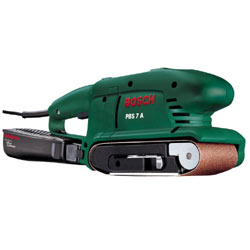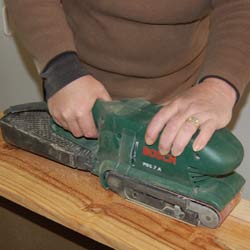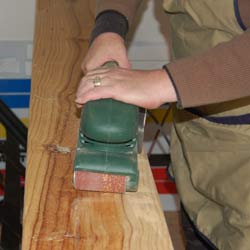Using a belt sander
My first experience with a belt sander could be compared to riding a bronco pony. Not that I've ever ridden a bronco, but I would imagine it was something similar. You need to have both hands on this big boy all the time.
A belt sander is ideal for sanding large areas of timber, such as hardwood floors, decks and long board, as this powerful tool removes a large amount of wood from your work surface quickly, particularly when using coarse grit sandpaper. Due to its high-speed power this power tools can ruin a project in an instant if not used properly.
Follow our guidelines when using a belt sander for the first time:
Hold the belt sander firmly on the handle and lift the sander off the surface before switching on. Position your other hand over the top of the front before lowering to the work surface. (see image below)
Slowly lower the sander onto the work piece. Hold tightly once on the surface as the belt sander will pull forward. You don't need to hold it in place, rather, allow the sander to move forward slowly along the direction of the wood grain.
You do not need to press down hard with the sander, simply guide the machine evenly across the surface in overlapping forward and backward strokes - similar to that used for painting a wall.
Before switching the power off, lift the sander off the work surface.
Use a belt sander on coarse or rough timber and finish off with a random orbit sander and finer grade sandpapers.
Safety first
Safety goggles, a face mask and an apron are a must when using a belt sander. Make sure that any nails or screws have been removed, or be cautious when sanding over these as they can cause the machine to jump out of your hands. As with an power tool - common sense is required when using a belt sander.
Changing the belt
When you notice that not much is happening to the surface of the wood it's time to change the sanding belt. Unplug the machine from the power point before doing anything else. Flip the release lever on the side of the machine to loosen pressure on the belt. This will make it easy to take out the old belt. Install the new belt by slipping it over the roller and plate, checking that it is correctly aligned before flipping the release lever back into locking position.



